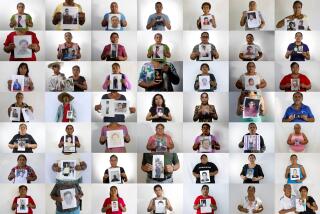Burgeoning Mexico Begins Head Count
- Share via
MEXICO CITY — Mexico is conducting a national census, already aware it has failed to halt an alarming population boom or to stem the growth of the largest, most polluted city in the world.
Some 610,000 census takers--more than the total population of nearby Belize--started working March 12 to carry out the once-a-decade Population and Housing Census.
Some were flown by helicopter to Mexico’s remotest regions to interview non-Spanish-speaking Indians in their native dialects. Others, equipped with sun visors and clipboards, plumbed the depths of Mexico City’s squatter communities.
The results, the first of which are due after midyear, are expected to be bleak.
Following a decade of economic stagnation and austerity, the population continues to grow at more than double the rate targeted for the year 2000, government officials said.
Antonio Puig, Mexico City director for the National Institute for Geographic Statistics and Information, said the number of poor peasants coming to the capital seeking better lives had reached 2,000 people per day.
” . . . Mexico City has the unfortunate distinction of overtaking Tokyo as the world’s largest metropolitan area,” he said.
President Carlos Salinas de Gortari recently predicted that, despite efforts to curb population growth, there would be 10 million more people in the country by the turn of the century--more than currently living in Belgium or Portugal, he said.
The Mexican population, now estimated at more than 85 million, has grown in the last decade at an average annual rate of 2.2%, according to Carlos Jarque, president of the National Institute for Geographic Statistics and Information.
In outlying areas of the capital, where even humble, half-built shacks carry the official green census sticker, residents said they saw the benefits of the head count and hoped the results would stir the authorities to action.
“Many people like me don’t have running water, and maybe the government will take account of this,” said Hector Martinez, an elderly man working in the street in Milpa Alta, on the southeastern rim of the capital.
The community--which 600 years ago stood up against Aztec warriors when they swarmed into what is now Mexico City--is again facing invasion from the sprawling capital, reputed to be the most dangerously polluted in the world.
New homes made of mortar sit on the arid soil where local farmers still struggle to produce nopal, an edible cactus. Donkeys trudge alongside heavy urban traffic on the highways.
Officials said Milpa Alta, like hundreds of other communities ringing the capital, may have almost doubled in size from a mostly rural population of about 35,000 in 1970.
Census takers, mostly in their early 20s, said they were having little trouble completing the survey--apart from occasionally encountering ferocious dogs or wealthy residents who decline to reveal their earnings.
With a vast publicity drive, six years of planning, a satellite-linked computer system and a $250-million budget, organizers anticipate that the survey will at least ease the government’s task of defining priority crisis areas.
“Most interesting is to see not just the large national aggregates, but also over a decade, what has happened to the lives of the different localities in the country--the indigenous population, the lives of children,” Jarque said.
Critics of the government’s population policy were more blunt, however.
Proceso, Mexico’s leading news magazine, said the census “will reflect the inability to meet planned demographic goals as well as the social deterioration of the greater part of the country’s population.”
More to Read
Sign up for Essential California
The most important California stories and recommendations in your inbox every morning.
You may occasionally receive promotional content from the Los Angeles Times.













